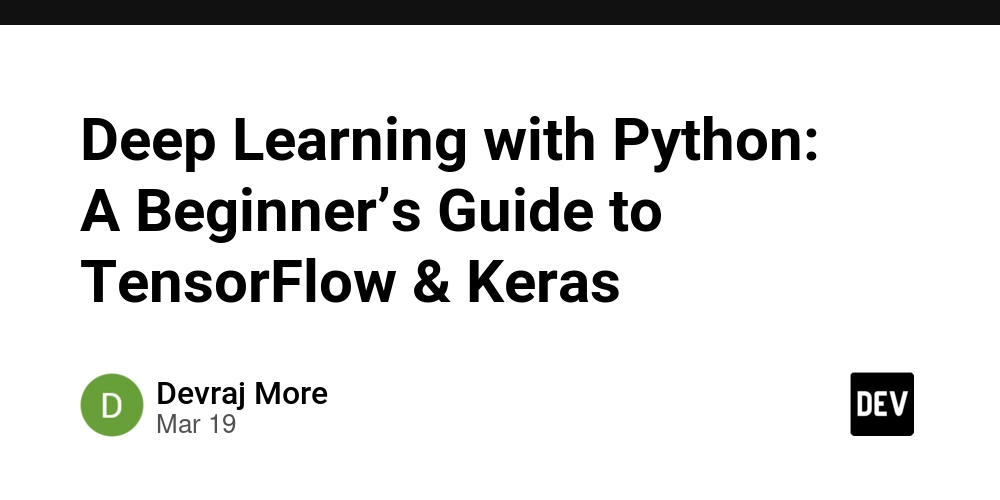Deep Learning with Python: A Beginner’s Guide to TensorFlow & Keras
Deep learning is transforming industries by enabling machines to learn and make decisions with minimal human intervention. From self-driving cars to voice assistants, deep learning plays a crucial role in modern artificial intelligence (AI). If you're new to this field, Python, along with TensorFlow and Keras, provides a beginner-friendly way to build powerful deep learning models. If you're looking to master deep learning, enrolling in data science courses in Bengaluru can help you gain practical skills in machine learning, neural networks, and AI applications. This guide will introduce you to deep learning concepts and how to implement them using TensorFlow and Keras. What is Deep Learning? Deep learning is a subset of machine learning that focuses on training artificial neural networks to recognize patterns and make decisions. Unlike traditional machine learning, deep learning models can handle large amounts of unstructured data, such as images, audio, and text, with remarkable accuracy. Why Use Deep Learning? Automates feature extraction Handles complex problems like image and speech recognition Improves performance with more data Reduces human intervention in decision-making Introduction to TensorFlow and Keras TensorFlow and Keras are two of the most popular libraries for deep learning in Python. TensorFlow: Developed by Google, TensorFlow is a powerful library that allows for large-scale machine learning and deep learning applications. Keras: A high-level API built on top of TensorFlow, Keras simplifies the process of building deep learning models with an intuitive and user-friendly interface. Setting Up TensorFlow and Keras To get started, install TensorFlow, which includes Keras as part of its API. pip install tensorflow Once installed, import the libraries: import tensorflow as tf from tensorflow import keras Building a Basic Deep Learning Model with Keras Let’s build a simple neural network using Keras to classify handwritten digits from the famous MNIST dataset. Loading the Dataset from tensorflow.keras.datasets import mnist Load MNIST dataset (x_train, y_train), (x_test, y_test) = mnist.load_data() Preprocessing the Data Normalize the pixel values to a range of 0 to 1 x_train, x_test = x_train / 255.0, x_test / 255.0 Creating the Neural Network Define the model model = keras.Sequential([ keras.layers.Flatten(input_shape=(28, 28)), # Flatten the input layer keras.layers.Dense(128, activation='relu'), # Hidden layer with 128 neurons keras.layers.Dense(10, activation='softmax') # Output layer for 10 classes ]) Compiling the Model model.compile(optimizer='adam', loss='sparse_categorical_crossentropy', metrics=['accuracy']) Training the Model model.fit(x_train, y_train, epochs=5) Evaluating the Model Evaluate on test data test_loss, test_acc = model.evaluate(x_test, y_test) print("Test accuracy:", test_acc) Understanding Neural Networks in Deep Learning Key Components of a Neural Network Input Layer: The data enters the model here. Hidden Layers: These layers process the data and extract patterns. Activation Functions: Functions like ReLU and softmax help in decision-making. Output Layer: Produces the final prediction. Types of Deep Learning Models Feedforward Neural Networks (FNNs) – Simple neural networks used for classification tasks. Convolutional Neural Networks (CNNs) – Used for image recognition. Recurrent Neural Networks (RNNs) – Ideal for sequential data like time series and speech. Transformers – Advanced deep learning models used in NLP (e.g., ChatGPT). Advantages of Learning Deep Learning in Bengaluru Bengaluru is known as the Silicon Valley of India, offering vast opportunities in AI and data science. Enrolling in data science courses in Bengaluru can provide: Hands-on training in deep learning frameworks like TensorFlow and PyTorch. Real-world projects to build a strong portfolio. Networking opportunities with industry experts and AI professionals. Job placement assistance in top tech companies. Career Opportunities in Deep Learning With expertise in deep learning, you can explore roles like: Data Scientist AI Engineer Machine Learning Engineer Deep Learning Researcher Computer Vision Engineer Conclusion Deep learning with Python, TensorFlow, and Keras is a game-changer in the AI industry. Learning how to build deep learning models will set you apart in the job market. If you’re serious about launching a career in AI and machine learning, enrolling in data science courses in Bengaluru will provide you with the skills and practical experience needed to excel.

Deep learning is transforming industries by enabling machines to learn and make decisions with minimal human intervention. From self-driving cars to voice assistants, deep learning plays a crucial role in modern artificial intelligence (AI). If you're new to this field, Python, along with TensorFlow and Keras, provides a beginner-friendly way to build powerful deep learning models.
If you're looking to master deep learning, enrolling in data science courses in Bengaluru can help you gain practical skills in machine learning, neural networks, and AI applications. This guide will introduce you to deep learning concepts and how to implement them using TensorFlow and Keras.
What is Deep Learning?
Deep learning is a subset of machine learning that focuses on training artificial neural networks to recognize patterns and make decisions. Unlike traditional machine learning, deep learning models can handle large amounts of unstructured data, such as images, audio, and text, with remarkable accuracy.
Why Use Deep Learning?
Automates feature extraction
Handles complex problems like image and speech recognition
Improves performance with more data
Reduces human intervention in decision-making
Introduction to TensorFlow and Keras
TensorFlow and Keras are two of the most popular libraries for deep learning in Python.
TensorFlow: Developed by Google, TensorFlow is a powerful library that allows for large-scale machine learning and deep learning applications.
Keras: A high-level API built on top of TensorFlow, Keras simplifies the process of building deep learning models with an intuitive and user-friendly interface.
Setting Up TensorFlow and Keras
To get started, install TensorFlow, which includes Keras as part of its API.
pip install tensorflow
Once installed, import the libraries:
import tensorflow as tf
from tensorflow import keras
Building a Basic Deep Learning Model with Keras
Let’s build a simple neural network using Keras to classify handwritten digits from the famous MNIST dataset.
- Loading the Dataset
from tensorflow.keras.datasets import mnist
Load MNIST dataset
(x_train, y_train), (x_test, y_test) = mnist.load_data()
- Preprocessing the Data
Normalize the pixel values to a range of 0 to 1
x_train, x_test = x_train / 255.0, x_test / 255.0
- Creating the Neural Network
Define the model
model = keras.Sequential([
keras.layers.Flatten(input_shape=(28, 28)), # Flatten the input layer
keras.layers.Dense(128, activation='relu'), # Hidden layer with 128 neurons
keras.layers.Dense(10, activation='softmax') # Output layer for 10 classes
])
- Compiling the Model
model.compile(optimizer='adam',
loss='sparse_categorical_crossentropy',
metrics=['accuracy'])
- Training the Model
model.fit(x_train, y_train, epochs=5)
- Evaluating the Model
Evaluate on test data
test_loss, test_acc = model.evaluate(x_test, y_test)
print("Test accuracy:", test_acc)
Understanding Neural Networks in Deep Learning
Key Components of a Neural Network
Input Layer: The data enters the model here.
Hidden Layers: These layers process the data and extract patterns.
Activation Functions: Functions like ReLU and softmax help in decision-making.
Output Layer: Produces the final prediction.
Types of Deep Learning Models
Feedforward Neural Networks (FNNs) – Simple neural networks used for classification tasks.
Convolutional Neural Networks (CNNs) – Used for image recognition.
Recurrent Neural Networks (RNNs) – Ideal for sequential data like time series and speech.
Transformers – Advanced deep learning models used in NLP (e.g., ChatGPT).
Advantages of Learning Deep Learning in Bengaluru
Bengaluru is known as the Silicon Valley of India, offering vast opportunities in AI and data science. Enrolling in data science courses in Bengaluru can provide:
Hands-on training in deep learning frameworks like TensorFlow and PyTorch.
Real-world projects to build a strong portfolio.
Networking opportunities with industry experts and AI professionals.
Job placement assistance in top tech companies.
Career Opportunities in Deep Learning
With expertise in deep learning, you can explore roles like:
Data Scientist
AI Engineer
Machine Learning Engineer
Deep Learning Researcher
Computer Vision Engineer
Conclusion
Deep learning with Python, TensorFlow, and Keras is a game-changer in the AI industry. Learning how to build deep learning models will set you apart in the job market. If you’re serious about launching a career in AI and machine learning, enrolling in data science courses in Bengaluru will provide you with the skills and practical experience needed to excel.




















































%20Abstract%20Background%20112024%20SOURCE%20Amazon.jpg)






















































































































![[The AI Show Episode 142]: ChatGPT’s New Image Generator, Studio Ghibli Craze and Backlash, Gemini 2.5, OpenAI Academy, 4o Updates, Vibe Marketing & xAI Acquires X](https://www.marketingaiinstitute.com/hubfs/ep%20142%20cover.png)
























































































































































































































































-Nintendo-Switch-2-–-Overview-trailer-00-00-10.png?width=1920&height=1920&fit=bounds&quality=80&format=jpg&auto=webp#)





















_Anna_Berkut_Alamy.jpg?#)













































































































![YouTube Announces New Creation Tools for Shorts [Video]](https://www.iclarified.com/images/news/96923/96923/96923-640.jpg)





































































![[Weekly funding roundup March 29-April 4] Steady-state VC inflow pre-empts Trump tariff impact](https://images.yourstory.com/cs/2/220356402d6d11e9aa979329348d4c3e/WeeklyFundingRoundupNewLogo1-1739546168054.jpg)





























































